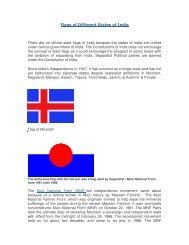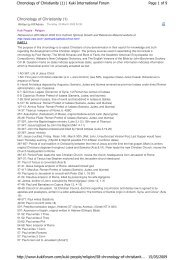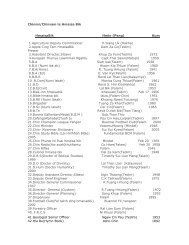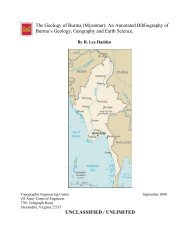abstract - Zomi Online Library
abstract - Zomi Online Library
abstract - Zomi Online Library
You also want an ePaper? Increase the reach of your titles
YUMPU automatically turns print PDFs into web optimized ePapers that Google loves.
15<br />
convince the tribes that we were both able and willing to reach their most distant villages and avenge raids committed<br />
within our terrritories and upon our people...During the next five years two more outrages were perpetrated and in 1888<br />
the Chin-Lushai community, known as the Shendus, entered into the Chittagong hills on a marauding expedition...<br />
9.3.2 The Tipperah border<br />
Tipperah lies south of Sylhet and north of Chittagong; the kingdom formerly included plains as well as the hills which<br />
merge into the Lushai country. The East India Company annexed the paying part of Tipperah, namely, the plains, in<br />
1761, but of the barren hills that fenced them no cognizance was taken. These hills became what we still know as<br />
Independent Tipperah, governed by a Rajah. From 1785, when we read that the Rajah was victorious over the outer<br />
Kukis who had just made a savage inroad into his territory, until the Lushai Expedtion of 1871-72, the Lushais were<br />
continually troubling Hill Tipperah. The year 1824 saw a series of raids by the then called “Poitoo Kukies“, who were said<br />
to number 50,000 or 60,000 and to be the most formidable and turbulent of the hill tribes.<br />
In 186o the Kukis again burst into the plains, burnt and plundered 15 villages, butchered 185 British subjects, and<br />
carried off about 100 captives, escaping into the hills before the troops could come to the scene. These raids were<br />
known as the “great Kuki invasion of 1860“, and the outrages were perpetrated in British territory and not in Independent<br />
Tipperah. During the same year, however, a fierce attack was made on the Rajah‘s territory, in which several villages<br />
were destroyed before the raiders were driven back into the hills. In 1871, when the Lushais were playing a havoc in the<br />
south of Assam, Hill Tipperah was not free from raids, and in that year a Political Agent was appointed to Hill Tipperah to<br />
assist the Rajah. This arrangement was discontinued in 1878, the conduct of our political relations with the State being<br />
entrusted to the Migistrate of Tipperah, who has an assistant residing in the hills.<br />
9.3.3. The Assam border<br />
After turning the Burmese conquerors out of Assam in 1824, the Government attempted to administer all that was not<br />
absolutely necessary for the control of the frontier through a Native Prince; this arrangement failed, and Assam became<br />
a non-regulation province in 1838. On its southern borders lay the Lushais, the principal tribes known to Assam being<br />
“Thadoe“ and “Poitoo Kukies.“ For many years, long before our occupation, the inhabitants of the plains to the south had<br />
lived in dread of the “Kukies“, who used to come down and attack the villages, massacring the inhibitants, taking their<br />
heads, and plundering and burning their houses. The first Kuki or Lushai raid mentioned as being committed in Assam<br />
was in 1826, from that year to 1850 the local officers were unable to restrain the fierce attacks of the hillmen on the<br />
south. Raids and outrages were of yearly occurence, and on one occasion the Magistrate of Sylhet reported a series of<br />
massacres by “Kookies“ in what was alleged to be British territory, in which 150 persons had been killed.<br />
In 1849 the Kuki outrages were so savage and numerous that Colonel Lister, then Commandant of the Sylhet<br />
Infantry and Agent for the Khasi Hills, was sent in the cold weather of 1849-50 to punish the tribes. His expedition was<br />
only partially successful, for he found the country so impracticable that he considered it unwise to proceed further than<br />
the village Mulla, which contained 800 houses and which he surprised and destroyed without opposition, all the male<br />
inhabitants being absent on a marauding excursion. This expedition, however, had the effect of keeping the Assam<br />
southern border tolerably free from disturbance up to the beginning of 1862, when raid recommenced...<br />
In the cold weather of 1868-69 the Lushais burnt a tea garden in Cachar and attacked Monierkhat, and an expedition<br />
was organized to follow the marauders, to punish the tribes concerned, and to recover the captives. This expedition was<br />
in command of General Nuthall and consisted ot three columns,but the heavy rains coming on, the want of provisions<br />
and lateness of the season caused the expedition to fail in its principle objects. No tribes were punished and no<br />
captives were recovered. The next season Mr. Edgar, the Deputy Commissioner of Cachar, made strenuous efforts to<br />
get into touch with the Lushais. Accompanied by a small escort he visited them across the border and left nothing<br />
undone to conciliate and make friends with them; his good intentions and friendly attitude, however, met with little<br />
success, for 1870-71 saw a series of Lushai raids on a more extensively organized scale and of a more determined<br />
character than any previous incursions of the kind...<br />
9.3.4 The Lushai Expedition The Government of India now decided that an expedition should be made into Lushai







